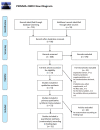Probiotics for Preventing Necrotizing Enterocolitis in Preterm Infants: A Network Meta-Analysis
- PMID: 33435456
- PMCID: PMC7827781
- DOI: 10.3390/nu13010192
Probiotics for Preventing Necrotizing Enterocolitis in Preterm Infants: A Network Meta-Analysis
Abstract
Background: Recent evidence supports a role of probiotics in preventing necrotizing enterocolitis (NEC) in preterm infants.
Methods: A systematic review and network meta-analysis of randomized controlled trials (RCTs) on the role of probiotics in preventing NEC in preterm infants, focusing on the differential effect of type of feeding, was performed following the Preferred Reporting Items for Systematic Reviews and Meta-Analyses (PRISMA) guidelines. A random-effects model was used; a subgroup analysis on exclusively human milk (HM)-fed infants vs. infants receiving formula (alone or with HM) was performed.
Results: Fifty-one trials were included (10,664 infants, 29 probiotic interventions); 31 studies (19 different probiotic regimens) were suitable for subgroup analysis according to feeding. In the overall analysis, Lactobacillus acidophilus LB revealed the most promising effect for reducing NEC risk (odds ratio (OR), 0.03; 95% credible intervals (CrIs), 0.00-0.21). The subgroup analysis showed that Bifidobacterium lactis Bb-12/B94 was associated with a reduced risk of NEC stage ≥2 in both feeding type populations, with a discrepancy in the relative effect size in favour of exclusively HM-fed infants (OR 0.04; 95% CrIs <0.01-0.49 vs. OR 0.32; 95% CrIs 0.10-0.36).
Conclusions: B. lactis Bb-12/B94 could reduce NEC risk with a different size effect according to feeding type. Of note, most probiotic strains are evaluated in few trials and relatively small populations, and outcome data according to feeding type are not available for all RCTs. Further trials are needed to confirm the present findings.
Keywords: necrotizing enterocolitis; network meta-analysis; preterm infants; probiotics; systematic review.
Conflict of interest statement
The authors declare no conflict of interest.
Figures





References
Publication types
MeSH terms
LinkOut - more resources
Full Text Sources
Other Literature Sources

